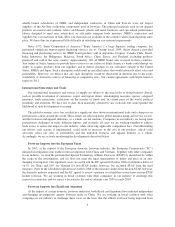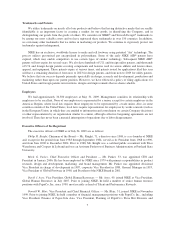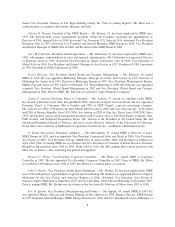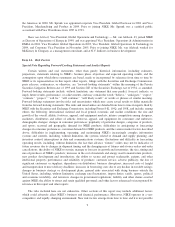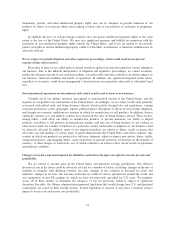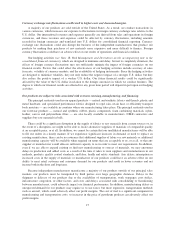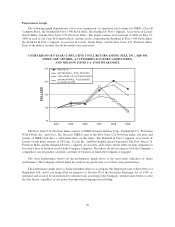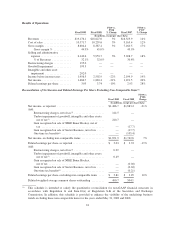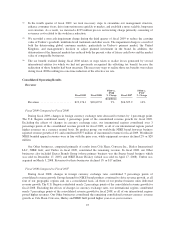Nike 2009 Annual Report Download - page 17
Download and view the complete annual report
Please find page 17 of the 2009 Nike annual report below. You can navigate through the pages in the report by either clicking on the pages listed below, or by using the keyword search tool below to find specific information within the annual report.Currency exchange rate fluctuations could result in higher costs and decreased margins.
A majority of our products are sold outside of the United States. As a result, we conduct transactions in
various currencies, which increases our exposure to fluctuations in foreign currency exchange rates relative to the
U.S. dollar. Our international revenues and expenses generally are derived from sales and operations in foreign
currencies, and these revenues and expenses could be affected by currency fluctuations, including amounts
recorded in foreign currencies and translated into U.S. dollars for consolidated financial reporting. Currency
exchange rate fluctuations could also disrupt the business of the independent manufacturers that produce our
products by making their purchases of raw materials more expensive and more difficult to finance. Foreign
currency fluctuations could have an adverse effect on our results of operations and financial condition.
Our hedging activities (see Note 18, Risk Management and Derivatives on the accompanying note to the
consolidated financial statement), which are designed to minimize and delay, but not to completely eliminate, the
effects of foreign currency fluctuations may not sufficiently mitigate the impact of foreign currencies on our
financial results. Factors that could affect the effectiveness of our hedging activities include accuracy of sales
forecasts, volatility of currency markets, and the availability of hedging instruments. Since the hedging activities
are designed to minimize volatility, they not only reduce the negative impact of a stronger U.S. dollar, but they
also reduce the positive impact of a weaker U.S. dollar. Our future financial results could be significantly
affected by the value of the U.S. dollar in relation to the foreign currencies in which we conduct business. The
degree to which our financial results are affected for any given time period will depend in part upon our hedging
activities.
Our products are subject to risks associated with overseas sourcing, manufacturing, and financing.
The principal materials used in our apparel products — natural and synthetic fabrics and threads, plastic and
metal hardware, and specialized performance fabrics designed to repel rain, retain heat, or efficiently transport
body moisture — are available in countries where our manufacturing takes place. The principal materials used in
our footwear products — natural and synthetic rubber, plastic compounds, foam cushioning materials, nylon,
leather, canvas and polyurethane films — are also locally available to manufacturers. NIKE contractors and
suppliers buy raw materials in bulk.
There could be a significant disruption in the supply of fabrics or raw materials from current sources or, in
the event of a disruption, we might not be able to locate alternative suppliers of materials of comparable quality
at an acceptable price, or at all. In addition, we cannot be certain that our unaffiliated manufacturers will be able
to fill our orders in a timely manner. If we experience significant increases in demand, or need to replace an
existing manufacturer, there can be no assurance that additional supplies of fabrics or raw materials or additional
manufacturing capacity will be available when required on terms that are acceptable to us, or at all, or that any
supplier or manufacturer would allocate sufficient capacity to us in order to meet our requirements. In addition,
even if we are able to expand existing or find new manufacturing or sources of materials, we may encounter
delays in production and added costs as a result of the time it takes to train suppliers and manufacturers in our
methods, products, quality control standards, and labor, health and safety standards. Any delays, interruption or
increased costs in the supply of materials or manufacture of our products could have an adverse effect on our
ability to meet retail customer and consumer demand for our products and result in lower revenues and net
income both in the short and long term.
Because independent manufacturers manufacture a majority of our products outside of our principal sales
markets, our products must be transported by third parties over large geographic distances. Delays in the
shipment or delivery of our products due to the availability of transportation, work stoppages, port strikes,
infrastructure congestion, or other factors, and costs and delays associated with consolidating or transitioning
between manufacturers, could adversely impact our financial performance. In addition, manufacturing delays or
unexpected demand for our products may require us to use faster, but more expensive, transportation methods
such as aircraft, which could adversely affect our profit margins. The cost of fuel is a significant component in
manufacturing and transportation costs, so increases in the price of petroleum products can adversely affect our
profit margins.
15


